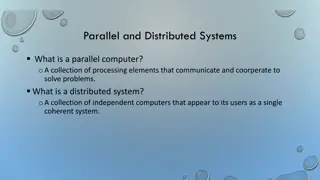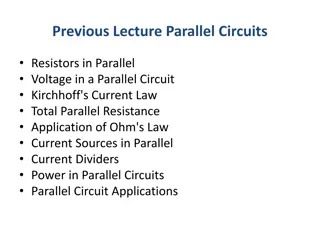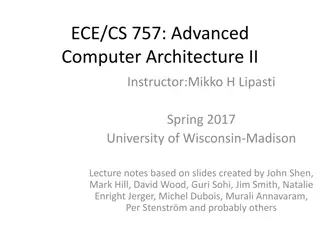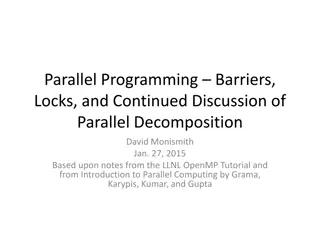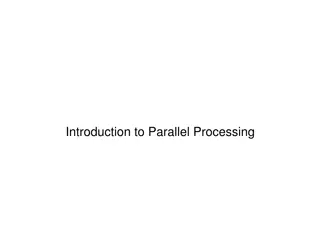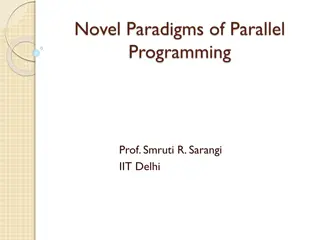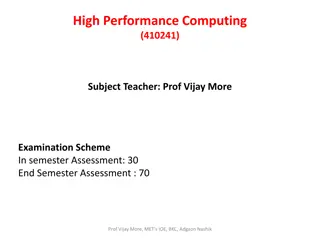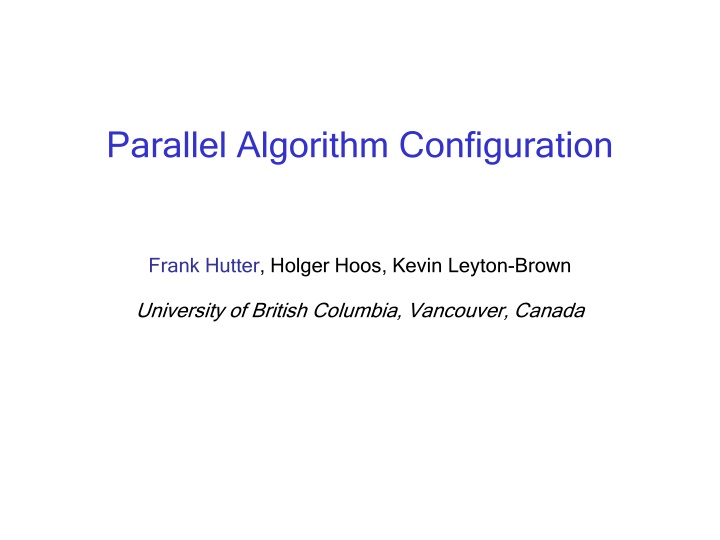
Parallel Algorithm Configuration: Optimization and Parallelism Study
Explore the world of parallel algorithm configuration through a systematic study of parameter optimization techniques, parallelization impacts, and advanced methodologies like ParamILS and d-SMAC. Discover how multiple independent runs and distributed algorithms enhance algorithm performance and speedups.
Download Presentation

Please find below an Image/Link to download the presentation.
The content on the website is provided AS IS for your information and personal use only. It may not be sold, licensed, or shared on other websites without obtaining consent from the author. If you encounter any issues during the download, it is possible that the publisher has removed the file from their server.
You are allowed to download the files provided on this website for personal or commercial use, subject to the condition that they are used lawfully. All files are the property of their respective owners.
The content on the website is provided AS IS for your information and personal use only. It may not be sold, licensed, or shared on other websites without obtaining consent from the author.
E N D
Presentation Transcript
Parallel Algorithm Configuration Frank Hutter, Holger Hoos, Kevin Leyton-Brown University of British Columbia, Vancouver, Canada
Algorithm configuration Most heuristic algorithms have parameters E.g. IBM ILOG CPLEX: Preprocessing, underlying LP solver & its parameters, types of cuts, etc. 76 parameters: mostly categorical + some numerical Automatically find good instantiation of parameters 2 Hutter, Hoos, and Leyton-Brown: Parallel Algorithm Configuration
Related work on parameter optimization Optimization of numerical algorithm parameters Population-based, e.g. CMA-ES [Hansen et al, '95-present] Model-based approaches: SPO [Bartz-Beielstein et al., CEC 05] Experimental Design: CALIBRA [Adenso & Laguna, OR 06] General algorithm configuration (also categorical parameters) Racing: I/F-Race [Birattari et al., GECCO 02, MH 07, EMOAA 09] Iterated Local Search: ParamILS [Hutter et al., AAAI 07 & JAIR 09] Genetic algorithms: GGA [Ansotegui et al., CP 09] Model-based approaches: SMAC [Hutter et al., LION 11] 3 Hutter, Hoos, and Leyton-Brown: Parallel Algorithm Configuration
Algorithm configuration works Problem Problem Algorithm name Algorithm name and #parameters and #parameters Speedups Speedups Reference Reference 4.5 500 1.6 218x 360 [Hutter et al., 07b] SAT Spear (26) [KhudaBukhsh et al., 09] SAT SATenstein (41) [Hutter et al., 07a] Most probable explanation (MPE) GLS+ (5) 2 52 3 118 [Hutter et al., 10] MIP CPLEX (76) [Vallati et al., 11] AI Planning LPG (62) 4 Hutter, Hoos, and Leyton-Brown: Parallel Algorithm Configuration
Can parallelization speed up algorithm configuration? Multiple independent runs of the configurator Our standard methodology for using ParamILS Here: first systematic study of this technique s effectiveness Parallelism within a single configuration run GGA [Ansotegui et al, CP 09] Evaluates 8 configurations in parallel & stops when one finishes BasicILS variant of ParamILS[Hutter et al, JAIR 09] Distributed target algorithm runs on a 110-core cluster Here: a new distributed variant of SMAC: d-SMAC 5 Hutter, Hoos, and Leyton-Brown: Parallel Algorithm Configuration
Overview Multiple independent configuration runs: an empirical study Distributed variant of model-based configuration: d-SMAC Conclusions 6 Hutter, Hoos, and Leyton-Brown: Parallel Algorithm Configuration
Overview Multiple independent configuration runs: an empirical study Distributed variant of model-based configuration: d-SMAC Conclusions 7 Hutter, Hoos, and Leyton-Brown: Parallel Algorithm Configuration
Parallelization by multiple independent runs Many randomized heuristic algorithms have high variance Some runs perform much better than others (different random seeds) We can exploit that variance! Multiple independent runs in sequence: random restarts Multiple independent runs in parallel Run multiple copies of an algorithm in parallel & return best result Perfect speedups for exponential runtime distributions [Hoos & St tzle, AIJ 99] Can reduce expected runtime even on a single core[Gomes&Selman, AIJ 01] 8 Hutter, Hoos, and Leyton-Brown: Parallel Algorithm Configuration
Multiple independent runs of configurators Our standard methodology for using ParamILS Perform 10 to 25 parallel ParamILS runs Select the run with the best training (or validation) performance How much do we gain by performing these parallel runs? 9 Hutter, Hoos, and Leyton-Brown: Parallel Algorithm Configuration
Experimental Setup 5 configuration scenarios from previous work [Hutter et al., CPAIOR 10] Optimize solution quality that CPLEX achieves in a fixed time limit 2010: ParamILS achieved substantial improvements Side effect of this paper: SMAC & d-SMAC even a bit better We studied k ParamILS, k SMAC, k d-SMAC 200 runs for each underlying configurator on each scenario To quantify performance of one run of (e.g.) k ParamILS: Draw bootstrap sample of k runs from the 200 ParamILS runs Out of these k runs, pick the one with best training performance Return its test performance 10 Hutter, Hoos, and Leyton-Brown: Parallel Algorithm Configuration
Example speedups for k ParamILS 5.6-fold speedup Configuration scenario: Regions 200 Small (or no) speedup for small time budgets Each run starts with the default configuration Substantial speedups for large time budgets 5.6-fold speedup from 4-fold parallelization? 11 Hutter, Hoos, and Leyton-Brown: Parallel Algorithm Configuration
Utilization of total CPU time spent Configuration scenario: CORLAT 4 ParamILS often better than 1 ParamILS, even on a single core I.e. > 4-fold wall clock speedups with k=4 Almost perfect speedups up to k=16; then diminishing returns 12 Hutter, Hoos, and Leyton-Brown: Parallel Algorithm Configuration
Utilization of total CPU time spent Configuration scenario: CORLAT Multiple independent runs are not as effective in SMAC SMAC is more robust [Hutter et al., LION 11] It has lower variance Parallelization by independent runs doesn t help as much 13 Hutter, Hoos, and Leyton-Brown: Parallel Algorithm Configuration
Overview Multiple independent configuration runs: an empirical study Distributed variant of model-based configuration: d-SMAC Conclusions 14 Hutter, Hoos, and Leyton-Brown: Parallel Algorithm Configuration
SMAC in a nutshell Algorithm performance data: (configuration, instance, performance) tuples Regression model predicts performance of new (configuration, instance) pairs Construct model Select new target algorithm runs Could parallelize this stage. But the two other sequential steps would become chokepoints Execute new target algorithm runs 15 Hutter, Hoos, and Leyton-Brown: Parallel Algorithm Configuration
Control flow in distributed SMAC Start new target algorithm runs Construct model Worker 1 Worker k Select new target algorithm runs Wait for workers and get results Note: synchronous parallelization 16 Hutter, Hoos, and Leyton-Brown: Parallel Algorithm Configuration
Selecting multiple promising configurations We leverage existing work on parallelizing model-based optimization Simple criterion from [Jones, 01] Yields a diverse set of configurations (detail for experts only: we minimize - with sampled values of ) Other approaches could be worth trying E.g. [Ginsbourger, Riche, Carraro, 10] Very related talk tomorrow @ 11:55am: Expected improvements for the asynchronous parallel global optimization of expensive functions: potentials and challenges Janis Janusevskis, Rodolphe Le Riche, and David Ginsbourger 17 Hutter, Hoos, and Leyton-Brown: Parallel Algorithm Configuration
d-SMAC with different numbers of workers 6.2-fold 2.6-fold 2.9-fold Speedups even for short runs! Almost perfect speedups with up to 16 workers Overall speedup factor with 64 workers: 21 52 Reduces 5h run to 6 15 min 18 Hutter, Hoos, and Leyton-Brown: Parallel Algorithm Configuration
Should we perform independent runs of d-SMAC? Typically best to use all cores in a single d-SMAC(64) run 4 d-SMAC(16) comes close: no statistical difference to 1 SMAC(64) in 3 of 5 scenarios 19 Hutter, Hoos, and Leyton-Brown: Parallel Algorithm Configuration
Experiments for a harder instance distribution d-SMAC(64) takes 40 minutes to find better results than the other configurators in 2 days 25 d-SMAC(64) takes 2 hours to find better results than 25 ParamILS in 2 days 20 Hutter, Hoos, and Leyton-Brown: Parallel Algorithm Configuration
Conclusion Parallelization can speed up algorithm configuration Multiple independent runs of configurators Larger gains for high-variance ParamILS than lower-variance SMAC 4 ParamILS better than 1 ParamILS even on a single CPU Almost perfect speedups with up to 16 ParamILS Small time budgets: no speedups Distributing target algorithm runs in d-SMAC Almost perfect speedups with up to 16 parallel workers Even for short d-SMAC runs Up to 50-fold speedups with 64 workers Reductions in wall clock time: 5h 6 min -15 min 2 days 40min - 2h 21 Hutter, Hoos, and Leyton-Brown: Parallel Algorithm Configuration
Future Work Asynchronous parallelization Required for runtime minimization, where target algorithm runs have vastly different runtimes Ease of use We needed to start cluster workers manually Goal: direct support for clusters, Amazon EC2, HAL, etc. 22 Hutter, Hoos, and Leyton-Brown: Parallel Algorithm Configuration




